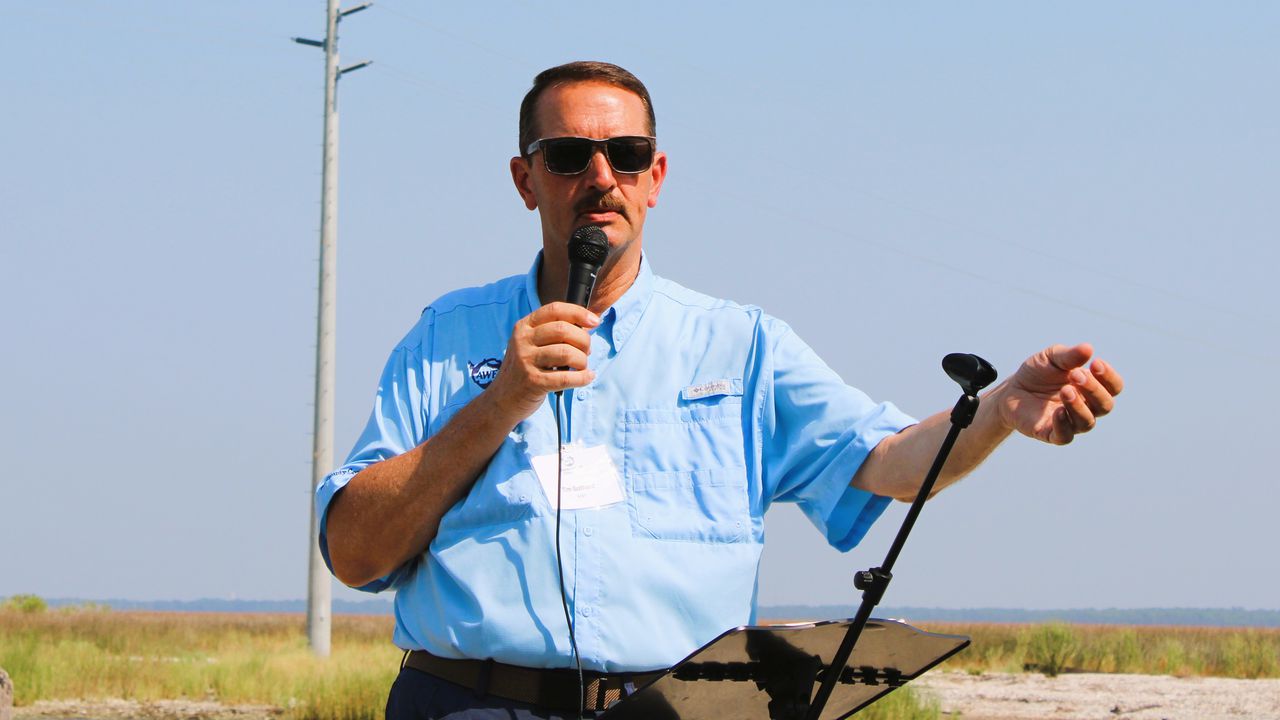Unprecedented Alabama oyster restoration effort: âThis is the big oneâ
As high-powered water cannons blasted tons of limestone off barges and into shallow coastal waters near Dauphin Island on Wednesday, conservation leaders celebrated an unprecedented effort to kick-start 77 acres of oyster habitat.
“Make no mistake about it,” Tim Gothard, executive director of the Alabama Wildlife Federation told the assembled dignitaries, seafood-industry figures and officials. “This is the big one.”
Gothard said that since making oyster restoration a priority, the AWF has worked to expand several other reefs in Mobile Bay. But this effort was in a class by itself, he said. He got agreement from Scott Bannon, director of the Marine Resources Division of the Alabama Department of Conservation and Natural Resources.
The state provides limited funding for oyster restoration efforts, Bannon said, so the Marine Resources Division and other interested parties pursue federal grants and develop partnerships to leverage the funds they do have. “To have 100% privately funded cultch planting, I think it’s absolutely unheard of,” Bannon said. “I don’t think we’ve had that occur in any other state, other than on a private lease. … It’s absolutely phenomenal that we’re getting 77 acres of public bottom that is privately funded. I can’t stress enough how unique that is and how valuable that is.”
This effort, conceived by the AWF, involved contributions from Vulcan Materials Co. and Cooper Marine worth hundreds of thousands of dollars. Vulcan donated 6,500 tons of limestone from a quarry in Tuscumbia; Cooper transported it the length of the state. Gothard said that the process of spreading in the water cost about $200,000. The AWF ponied up half that amount directly and recruited four partners, each of whom matched a quarter: the Coastal Land Trust, the Thomas E. Jernigan Foundation, the J.L. Bedsole Foundation and PowerSouth Energy Cooperative.
Tim Gothard, executive director of the Alabama Wildlife Federation, speaks about the AWF’s efforts to restore healthy oyster reefs on Mobile Bay.Lawrence Specker | [email protected]
The rock is being used as cultch, a term for any hard clean surface that free-floating oyster larvae can fasten onto. For larvae that land in mud, the story ends there. Those that bond to suitable cultch have a fighting chance to grow into a juvenile form called spat, taking 18 months to two years to develop into mature oysters.
In an established oyster reef, the shells of past generations provide the cultch for future generations of larvae. Over centuries this can create huge deposits of old shell, and this was the case in Mobile Bay. But there was a period in history where this material was mined for use as aggregate in roadbuilding and other construction, disrupting the natural process. That’s one reason that oyster harvests in Mobile Bay are a small fraction of what they were a century ago.
“Over history, cultch material became a commodity,” said Bannon. But since those days, science has provided an eye-opening understanding of the critical role oysters play in a coastal ecosystem.
“Having a healthy oyster reef is vital to everything we do in this bay system,” Bannon said. “I call them the foundational critter. Water quality: They help keep that water clean. They feed everything from the bottom dwellers up. … Without them the fishing doesn’t exist. Harvest doesn’t exist. Clean water doesn’t exist. Livelihoods don’t exist. We have to have them.”
Bannon said it was not to be taken lightly that the AWF has decided to put its muscle behind oyster restoration efforts. The AWF is a statewide organization, so it has a natural interest in statewide wildlife issues, such as those that benefit deer and turkey hunters. For it to back a coastal effort is a very deliberate and significant decision, Bannon said.
Gothard said the appreciation was a two-way street.
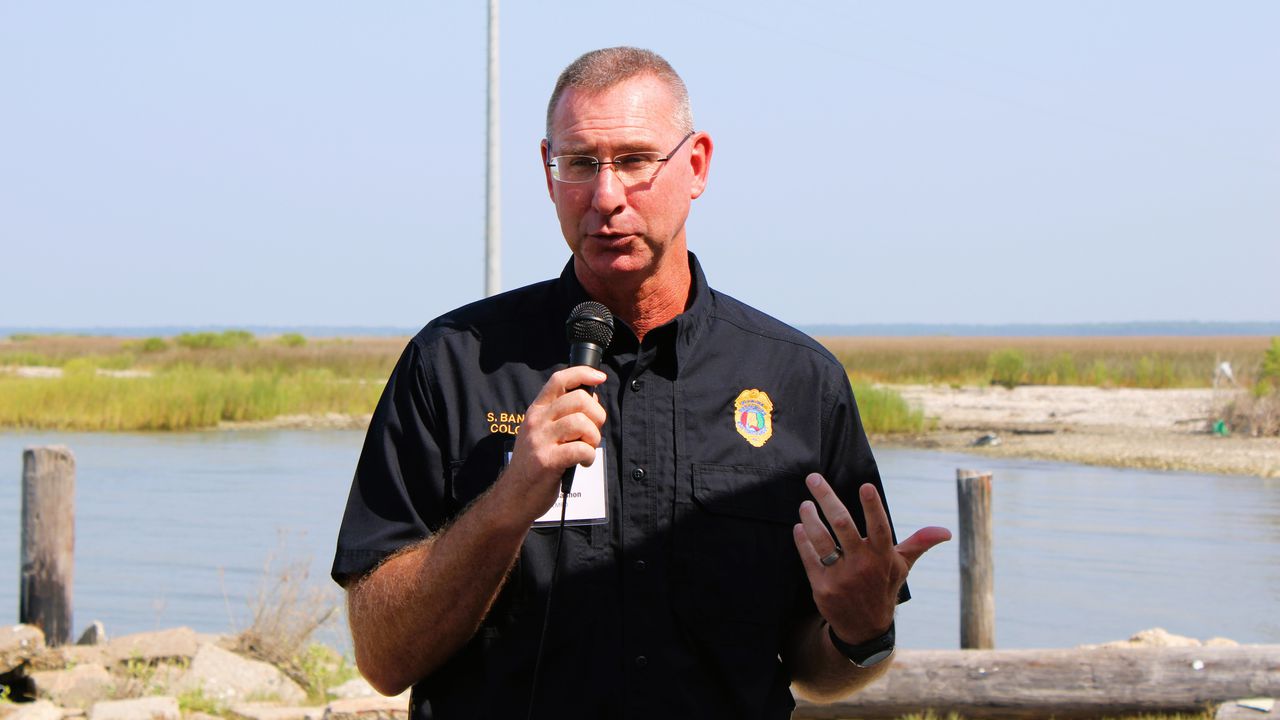
Scott Bannon, director of the Marine Resources Division of the Alabama Department of Conservation and Natural Resources, speaks about the importance of healthy oyster reefs.Lawrence Specker | [email protected]
“MRD sat down with us and we just asked the question: ‘Where is the right fit for AWF to have a meaningful impact?’ And it didn’t take us very long to arrive at relic oyster reef restoration,” he said.
“About 18 months ago, Scott Bannon and the folks at Marine Resources Division were kind enough to share with us the draft of Alabama’s comprehensive oyster restoration strategy,” Gothard said. “So we started looking at that and formulating some ideas about maybe how we could materially assist the goals of that comprehensive plan.”
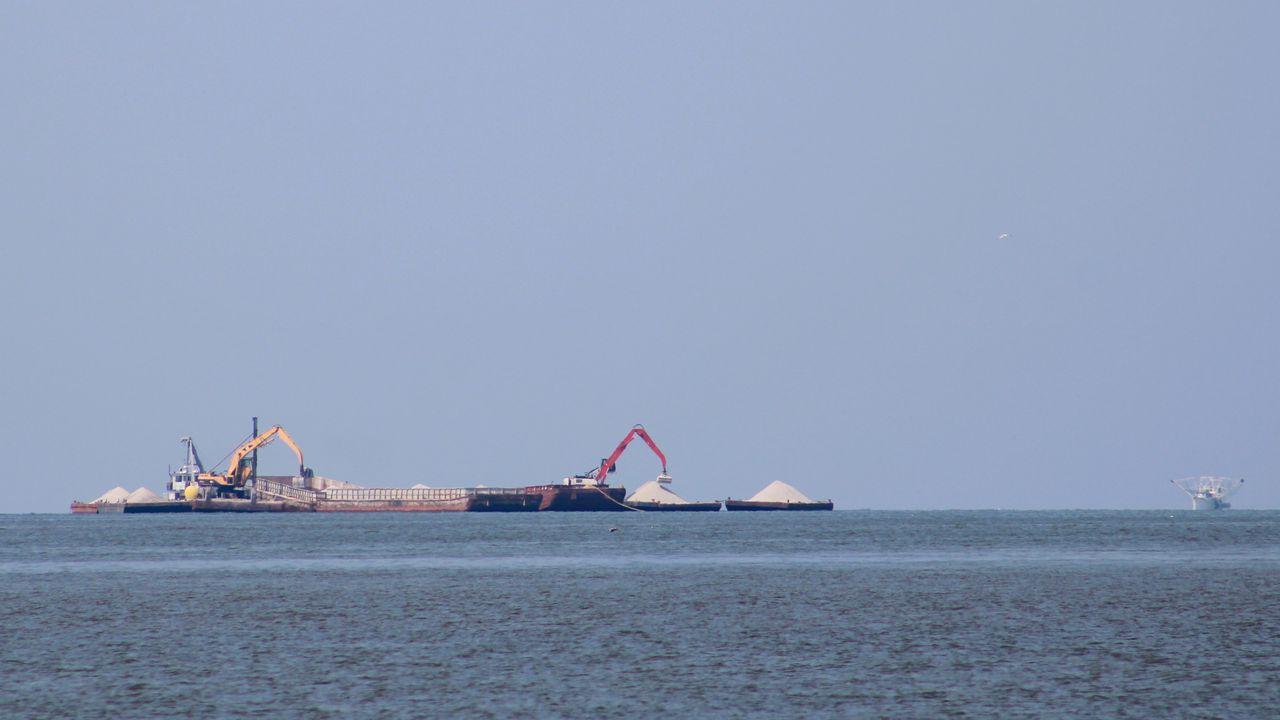
Heavy barges carried 6,500 tons of limestone from a north Alabama quarry to coastal waters in August 2023. On Aug. 23 they were positioned near Cedar Point West, so that the rock could be transferred to smaller barges and taken into shallow waters.Lawrence Specker | [email protected]
Initially, planners considered an area in waters known as Cedar Point East. That’s east of the last spit of mainland before the causeway running south to the Dauphin Island Bridge. MRD scientists took a close look at those waters, and their observations suggested the site wasn’t ideal. That led to a decision to execute the project in Cedar Point West, on the west side of the roadway.
You might think that once the north Alabama limestone reached Lower Alabama waters, the rest would be as simple as pulling a barge up to the spot and dumping the rock in with a crane. But no.
The deep-draft barges that made the voyage downstate had to be parked well away, because the waters at the project site were far too shallow for them. The rock was transferred by crane onto smaller barges, which a tiny tug named the Capt. Curtis pushed to the site. There, another tug named the Bubba E. stood ready with a barge equipped with high-volume water cannons.
In a slow-moving dance of tugs, one barge at a time was tied alongside the Bubba E’s battery of water cannons. Once all was ready, it took only a few minutes for the cannons to scour tons rock off the deck and into the water. Gothard said this process was chosen because it fanned the material out rather than leaving it in clumps.
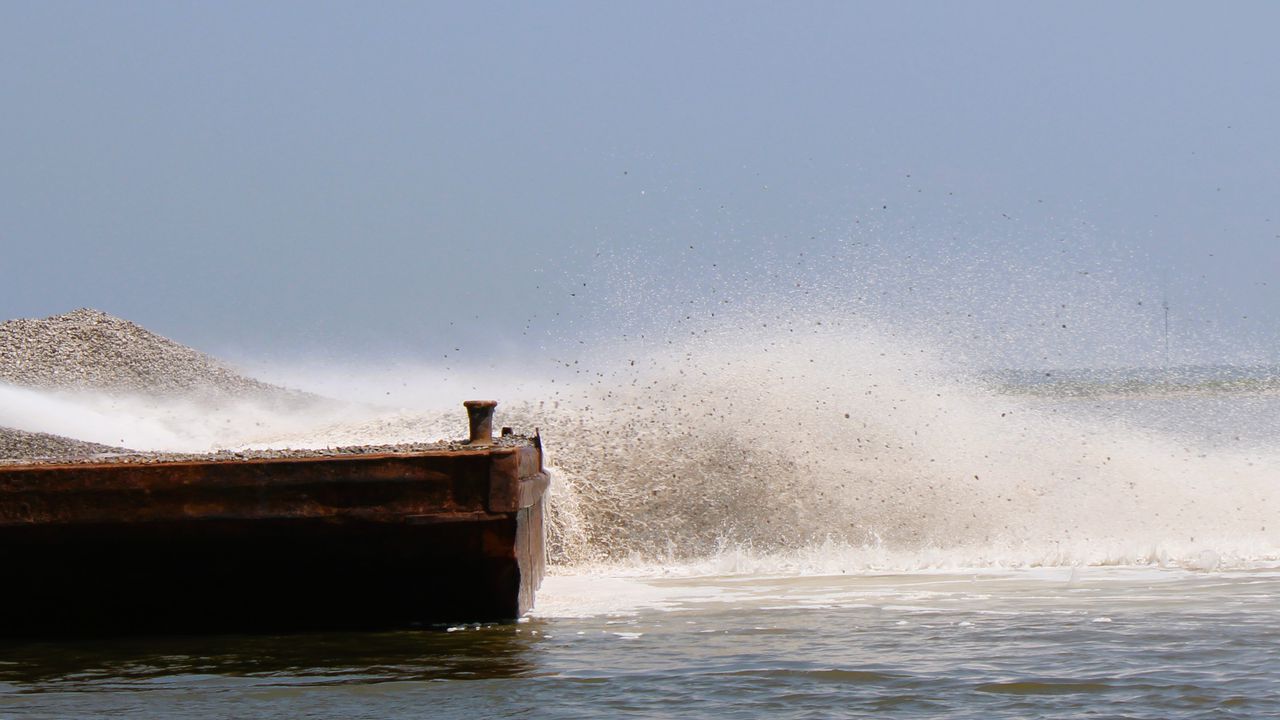
Limestone rock from north Alabama flies into the waters in a coastal area known as Cedar Point West on Aug. 23, 2023. The rock is intended to serve as cultch, providing the hard surfaces needed for larval oysters to attach and grow.Lawrence Specker | [email protected]
The work, begun on Wednesday, was expected to continue at least through Thursday.
From there, it’s up to the oysters. Gothard and Craig Newton, a Marine Resources Division biologist, said the site had been chosen to give the best odds of success. Newton said the area has some protection from seasonal freshwater surges coming down the bay and tends to have good oxygen levels. Salinity and oxygenation are just two of the variables in the delicate environmental balance that oysters need to thrive.
“We chose the site with MRD specifically because it is next to some of the most productive oyster waters here in the bay,” said Gothard. “So, being close to productive oyster beds, it means those oyster beds are naturally going to release a lot of larvae. … It creates a very high likelihood that the natural larvae in this system will attach to this new material and grow.”
“It’s the right time of the year for the fall spat set,” said interested observer Avery Bates, vice president of the Organized Seafood Association. Like Gothard and Newton, he said it’ll be 18 months to two years before the payoff comes.
And that’s if things go right. Droughts or unusually heavy rains inland can affect the salinity of the water, pushing it outside healthy limits for oysters. Temperature and other factors can do the same to oxygen levels. Tropical storms can wreck oyster beds in shallow waters.
But the payoff, if everything goes well, is potentially great. Partly that’s because of what the “foundational critters” do for the environment, partly it’s economic.
“It’s not way that we can lose, environmentally or job wise,” said Bates. “You’ll see two to three hundred people out here working, any given day when the weather’s decent. That turns into dollars and cents.”
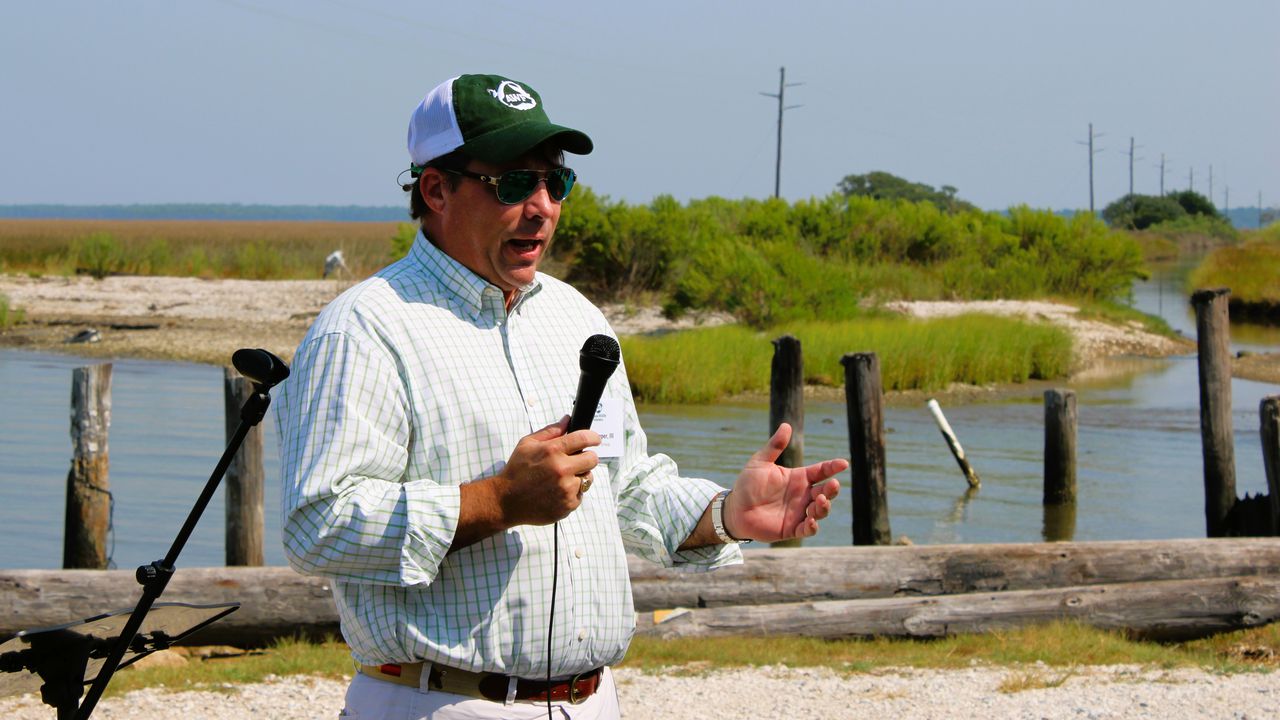
Angus Cooper III speaks about the Alabama Wildlife Federation’s decision to put an emphasis on oyster restoration.Lawrence Specker | [email protected]
“Everything that was contributed, everything that was given by these contributors, will mostly stay in Mobile County,” Bates said. The impact flows from harvesters, to seafood processors, to restaurants, he said. “The multiplying factor is great. Everybody that gets to do it will be able to pay their light bill, pay their gas bill.”
“26 years I’ve driven across this bridge,” said Bannon, referring to the nearby Dauphin Island span. “And 26 years, Avery Bates, [Bayou La Batre Mayor] Henry Barnes, [Dauphin Island] Mayor Collier, some of these folks sitting here, we have known each other that long. We know the importance of what you see around you when you come across this bridge. During Deepwater Horizon, when we shut everything down, was probably one of the worst days of my career, to drive across this bridge and stop and there was zero activity.”
Restoring reefs and building resiliency into the system takes a massive, multi-partner commitment, Bannon said.
Angus Cooper III, speaking for Cooper Marine and the AWF, said the AWF’s isn’t finished, when it comes to that effort.
“We’re just glad to be part of getting something started, and I can promise you this,” he said. “There’s more to come.”
For more on the Alabama Wildlife Federation’s Oyster restoration work, visit www.alabamawildlife.org.
Related:
North Alabama rock has date with south Alabama oysters
These researchers are scaring baby oysters with crab pee. For science.
How a bad day fishing inspired an Alabama chef’s national cook-off win
